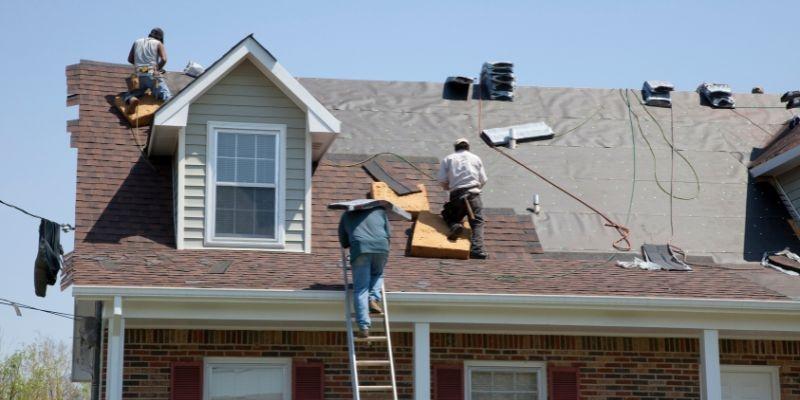A well-maintained roof is essential for protecting your home from the elements, enhancing energy efficiency, and maintaining its structural integrity. However, even the most durable roofs can experience wear and tear over time. From minor leaks to damaged shingles, roofing issues can arise unexpectedly, threatening the comfort and safety of your home. While major roofing repairs may require professional help, many issues can be addressed with a bit of knowledge, the right tools, and some elbow grease.
In this article, we’ll explore the top 10 repair tips for better roofing, designed to help homeowners maintain and extend the lifespan of their roofs. These practical tips will guide you through the process of diagnosing common roofing problems, preventing future damage, and performing essential repairs to keep your roof in top condition.
1. Conduct Regular Inspections
Before you can address any roofing issues, it’s essential to know what you’re dealing with. Regular roof inspections—ideally conducted at least twice a year—are the first step in identifying problems early before they escalate. Inspections should focus on visible areas, such as the shingles, flashing, gutters, and roof edges, as well as less accessible areas, such as the attic and under the eaves.
Tip: Use binoculars to inspect your roof from the ground to avoid climbing up unnecessarily. If you do need to get on the roof, always use a sturdy ladder and follow safety precautions.
2. Repair Missing or Damaged Shingles
One of the most common roofing issues is missing or damaged shingles, which can occur due to wind, hail, or general wear and tear. If left unaddressed, missing shingles can lead to leaks and further damage to the roof deck. Fortunately, replacing individual shingles is a straightforward repair that can be done with a few basic tools.
Tip: When replacing shingles, ensure that the new ones match the existing ones in size, color, and style. Start by lifting the edges of the surrounding shingles to remove the damaged ones, then slide the new shingles into place and secure them with roofing nails.
3. Fix Leaks Promptly
A leaky roof is one of the most urgent issues you may encounter, as even a small leak can quickly turn into a much larger problem. Leaks often occur around roof penetrations such as chimneys, vents, or skylights, as well as along seams in the roofing material. If you notice water stains on your ceiling or walls, it’s essential to locate and fix the source of the leak as soon as possible.
Tip: To locate a leak, go into the attic on a dry day and look for signs of moisture or water marks on the underside of the roof. Once the source is found, apply roofing cement to seal the area, ensuring a waterproof seal.
4. Inspect and Repair Flashing
Flashing is the metal or rubber material that seals joints and seams on your roof, particularly around chimneys, vents, and skylights. Over time, flashing can corrode or become loose, leading to leaks. To ensure a watertight seal, inspect the flashing regularly and make repairs as needed.
Tip: If you find damaged flashing, remove the old flashing and replace it with new material. For a better seal, apply roofing cement or sealant around the edges to prevent water from seeping underneath.
5. Clear Debris from Gutters and Roof
Clogged gutters and roof valleys can cause water to back up and pool on your roof, potentially leading to leaks and water damage. Regularly clearing debris such as leaves, twigs, and moss from your gutters and roof can prevent this issue. Pay special attention to areas where water can easily collect, such as the roof’s valleys, which are the low points where water flows.
Tip: Use a roof rake or blower to clear debris from your roof. For gutters, use a sturdy ladder to remove leaves and twigs, and consider installing gutter guards to prevent future build-up.
6. Address Granule Loss on Asphalt Shingles
Over time, the granules on asphalt shingles can become worn or washed away due to exposure to the elements. This can result in shingles that are less effective at protecting your roof from the sun’s UV rays and can also lead to premature aging. While some granule loss is normal, significant damage may require replacing the affected shingles.
Tip: If you notice large patches of granule loss on your shingles, it’s time to replace those shingles. You can also address small areas by applying a roof coating designed to protect against UV damage.
7. Seal and Protect Roof Penetrations
Roof penetrations, such as vents, chimneys, and pipes, are common places for leaks to occur. Over time, the seals around these penetrations can deteriorate, leading to water infiltration. Regularly inspect and maintain the seals around these areas to keep your roof leak-free.
Tip: Apply a high-quality sealant around roof penetrations and re-caulk any areas where the seal has worn away. If the existing flashing is damaged, replace it with new material to create a secure, watertight seal.
8. Fix Roof Ventilation Issues
Proper roof ventilation is crucial for maintaining a healthy attic environment. Without adequate ventilation, heat and moisture can build up, leading to potential problems such as mold growth, wood rot, and premature aging of your roofing materials. If you notice signs of poor ventilation, such as a stuffy attic or excessive moisture, it’s essential to address the issue promptly.
Tip: Ensure that your roof has both intake vents (typically at the eaves) and exhaust vents (near the ridge of the roof). If your ventilation system is inadequate, consider installing additional vents to improve airflow and prevent damage from heat and humidity.
9. Reinforce Roof Structure if Necessary
Over time, the structural components of your roof, such as the rafters and trusses, may begin to weaken or shift. This can cause sagging, bowing, or other issues that compromise the stability of your roof. If you notice signs of structural damage, such as uneven rooflines or sagging in the attic, it’s important to address the issue before it worsens.
Tip: Reinforcing your roof structure may require the help of a professional contractor, as this type of repair involves the use of specialized materials and techniques. Don’t attempt to fix structural issues without proper training and expertise.
10. Apply a Protective Roof Coating
A roof coating can extend the life of your roof by providing an extra layer of protection against the elements. Roof coatings are available in a variety of materials, including acrylic, elastomeric, and silicone, and can be applied to both flat and sloped roofs. These coatings help prevent water infiltration, protect against UV damage, and improve energy efficiency by reflecting sunlight.
Tip: Before applying a roof coating, ensure that your roof is clean and free of debris. Apply the coating evenly and allow it to cure according to the manufacturer’s instructions for optimal results.
Conclusion
Maintaining a healthy, functional roof is key to protecting your home from the elements and preserving its value. By following these top 10 roofing repair tips, you can address common issues before they turn into costly problems. Regular inspections, prompt repairs, and proper maintenance can extend the lifespan of your roof, ensuring that it continues to provide the protection and comfort your home needs for years to come.
Remember, some roofing repairs, especially those involving structural issues or complicated leaks, may require professional help. Always consult a qualified roofing contractor if you’re unsure about how to proceed or if the repair is beyond your expertise. By staying proactive and keeping your roof in good condition, you’ll safeguard your home and enjoy peace of mind through every season.

